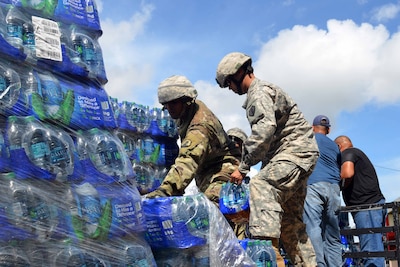By Jim Garamone DoD News, Defense Media Activity
WASHINGTON, Oct. 2, 2017 — Puerto Rican and federal
officials are working as a unified coordination group and progress is being
made in all lines of effort on the island, but Hurricane Maria's devastation
was so extreme and widespread that the island remains in emergency mode, Gov.
Ricardo Rossello said in San Juan today.
Government and nongovernmental agencies are working together
to deliver food, water and fuel to people throughout the island commonwealth,
he said.
Progress is being made in all lines of effort, the governor
stressed, but he acknowledged that much more needs to happen. His government is
working "effectively with [the Federal Emercency Management Agency] and
the Department of Defense, who are helping extensively with all of the
logistics and the efforts we have on the ground," he said.
About 7,200 service members of all services and components
are on the ground in Puerto Rico, the governor said, employed in areas such as
transportation, security, fuel units and medical efforts.
Army Lt. Gen. Jeffrey S. Buchanan, the U.S. Northern Command
representative on the island and the Defense Department's liaison to the
FEMA-led effotrt, told National Public Radio that Puerto Rico has received
everything he has asked for from Northcom and DoD.
The Navy amphibious assault ship USS Wasp, with three
embarked helicopters and 10 additional aircraft, will arrive tomorrow. Eight
Marine Corps MV-22 Ospreys and two KC-130 Hercules transport planes also will
deploy to the island.
The Navy hospital ship USNS Comfort is due to arrive in
Puerto Rico tomorrow. The Military Sealift Command ship is crewed with 800
medical personnel and support staff to support 250 patient beds. The ship will
fall in on a medical system that is recovering from the storm. The governor said
that assessments of the hospital system are complete and that 10 hospitals are
back on the electrical grid, with others operating via generators. FEMA
officials have worked up a fuel distribution system to ensure uninterrupted
electricity at those facilities, Rossello said.
Fuel is a major and necessary commodity. More than 759 of
1,120 retail gas stations have reopened, and waiting times for gas and diesel
fuel have dropped drastically, he added, and about 65 percent of large grocery
and big-box stores have reopened.
After Maria struck the island, all airports and seaports
were inoperable. Now all 10 airports are reopened, the governor said, and eight
vital seaports are accepting cargoes.
Some 37 percent of residents now have cellular phone
service, Rossello said. "We have 270 antennas that are up," he added.
"We have more than 1,700 antennas in Puerto Rico."
Transportation within the island is improving. Crews are
clearing roads and repairing roads and bridges as they move along. Aviation
assets – including military helicopters – are providing commodities to those
communities where road are still blocked.
"We want to add more efforts from the private sector to
help repair and open roadways in Puerto Rico, making our logistical objectives
more clear," the governor said. "By the end of the week, we will have
75 percent of the public transportation efforts working."

No comments:
Post a Comment